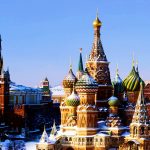 From 2014-mid 2016, the economic sanctions placed on Russia led to the devaluation of the ruble which sank from 28 rubles to the dollar to 70 rubles by early 2015. Russia was then hit by the collapse in oil prices which greatly affected the economy as the country is the 3rd largest oil producer in the world and the second-largest oil exporter. Both of these setbacks led to a severe recession. However, Russia has emerged from the crisis thus proving to be quite resilient in the face of such difficulties. Oil prices have staged a comeback and have alleviated financial pressures in the economy. Prices have rebounded from a low of $29 a barrel and stand at $53 today.
From 2014-mid 2016, the economic sanctions placed on Russia led to the devaluation of the ruble which sank from 28 rubles to the dollar to 70 rubles by early 2015. Russia was then hit by the collapse in oil prices which greatly affected the economy as the country is the 3rd largest oil producer in the world and the second-largest oil exporter. Both of these setbacks led to a severe recession. However, Russia has emerged from the crisis thus proving to be quite resilient in the face of such difficulties. Oil prices have staged a comeback and have alleviated financial pressures in the economy. Prices have rebounded from a low of $29 a barrel and stand at $53 today.
Revenue from energy production funds about 40% of Russia’s government budget. Lower energy prices resulted in less income and the ruble fell dramatically. However, the ruble won’t stay down forever and when it inevitably rises, Russian stocks stand to benefit greatly (59 rubles to the dollar 21.01.17). President Trump appears to be pursuing a positive relationship with Russia. A more stable U.S. Russia relationship points to positive news for Russian stock prices. We also like that the Central Bank of Russia has been aggressively buying gold with its dollar reserves while gold prices were at 7-year lows and have been on a physical bullion buying spree for over a decade. As Evgeny Federov, a Russian lawmaker from Russia’s United Russia Party stated: ‘The more gold a country has, the more sovereignty it will have if there’s a cataclysm with the dollar, the euro, the pound or any other reserve currency’. A good strategy in our opinion.
Europe wants to resume business dealings with Russia as the continent does not have enough naturally occurring energy to meet it’s energy requirements. Germany is in the process of phasing out its nuclear capacity and coal mines across Europe are struggling for lifelines due to increasing environmental regulations. 500 million people in Europe need to heat their homes for up to 6 months a year and the winters in Europe have been getting increasingly colder. Europe is therefore increasingly dependant on Russia to meet it’s energy needs. Russia has 25% of the world’s proven gas reserves and Europe acquires 33% of its gas reserves from Gazprom (the Russian energy giant). We purchased the VanEck Vectors Russia ETF on 9 August 2016 and have enjoyed a 15.63% rise since then. From a technical standpoint, the short-term, intermediate-term and long-term trends remain intact and RSX looks like it is a good long-term buy. Energy companies make up 36.8% of the ETF and Gazprom incidentally accounts for almost 8%. Other major holdings include:
| Top 10 Holdings (60.08% of Total Assets) |
|---|
|